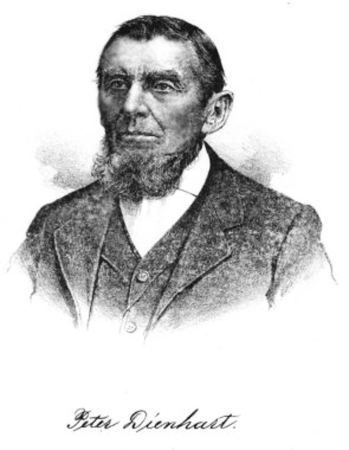 PETER
DIENHART, retired boot maker and shoe merchant, West Lafayette, is
a native of Prussia, Germany, born in the town of Pinsport, on the river
Moselle, February 16,1816, a son of Joseph and Mary (Kersten) Dienhart.
The father was a farmer and wine-grower in his native country, which he
followed until his death, which occurred in the year 1845. The mother
of our subject died February 24, 1821. They were the parents of five
children, named Peter M., Peter, Anna M., Matthew and Joseph.
Peter and Peter M. came to America, the other three children remaining
in their native country. Peter, the subject of this sketch, was reared
to manhood at his birthplace, receiving but limited educational advantages.
He assisted his father with the work of his vineyard for several years,
and subsequently served an apprenticeship at the shoemaker's trade.
PETER
DIENHART, retired boot maker and shoe merchant, West Lafayette, is
a native of Prussia, Germany, born in the town of Pinsport, on the river
Moselle, February 16,1816, a son of Joseph and Mary (Kersten) Dienhart.
The father was a farmer and wine-grower in his native country, which he
followed until his death, which occurred in the year 1845. The mother
of our subject died February 24, 1821. They were the parents of five
children, named Peter M., Peter, Anna M., Matthew and Joseph.
Peter and Peter M. came to America, the other three children remaining
in their native country. Peter, the subject of this sketch, was reared
to manhood at his birthplace, receiving but limited educational advantages.
He assisted his father with the work of his vineyard for several years,
and subsequently served an apprenticeship at the shoemaker's trade.
In April, 1846 he bade farewell to friends and fatherland and went to Havre de Gras, where he took passage on the sailing vessel "Oneider" for America, and after an ocean voyage of thirty-two days he arrived at New York City on the 22d day of May, 1846. There he found seat work at a private shoe-shop, at his trade. While in that great city he experienced many hardships and privations. He received as a compensation for his work but $4 per month, and his only place of rest at night was in a basement, where he reposed on a hard wooden bench covered over with little straw, and a blanket thrown over him. In July, 1846, he left the shoe-shop and went to work on a brick-yard on the North River, at Blinchpoint, at a compensation of $12 per month. After leaving the brick-yard he went by canal and wagon route, by way of Vermont, to New Hampshire, where he went to work on a railroad. He quit work on the railroad and returned to New York City on the 23d of December, 1846.
In January, 1847, he found employment at his trade, making brogan shoes for the Mexican war service, and during this time made several pairs for General Winfield Scott. In July, 1847, he left for the West by way of Cleveland, Ohio, he making the trip by river and canal from Cleveland. He stopped at Fort Wayne and worked at his trade during part of the 1847-'48. After leaving Fort Wayne he took the route by canal, and arrived at La Fayette, Tippecanoe County, Indiana, in April, 1848. On arriving at his destination he invested his small capital ($30) in a small stock of leather and tools, and by strict attention to his work and persevering energy he soon built up a large trade, which extended for many miles around. He was the third shoemaker in La Fayette, and soon became well and favorably known as a skilled and reliable workman. He carried on the boot and shoe business until 1872, since which year he has devoted his attention to wine-growing.
He is the owner of a fine fruit farm of eighty acres, besides another valuable farm of sixty acres, both located in Wabash Township. He also has two and a half acres surrounding his residence, located on the high bluff of the Wabash River, in West La Fayette. He also owns the Big Four Hotel in La Fayette, situated on the corner of Second and South streets, going to Germany and France to get the plan on which it was built. He was one of the first German settlers, and has since become one of the most respected citizens of the county. By strict economy and persevering industry in his younger years he can now enjoy the fruits of his years of toil.
Mr. Dienhart has been twice married, his first wife, whose maiden name was Barbara Pfeifner, dying in the year 1869. Six children were born to this union, of whom three are now living- Peter P., Henry W., and John F. Mr. Dienhart, in 1872, made a trip to his old home in Germany, bringing back with him Miss Mary Liell, an early schoolmate, whom he made his wife May 9, of that year. She is a native of Germany, and for twenty-five years she was engaged in the dry goods and grocery business in her native country. By his second marriage Mr. Dienhart has had four children. But one of them, a son, William, is living. Both Mr. and Mrs. Dienhart are members of the Roman Catholic Church, and he is also a charter member of the St. Joseph Society. In politics he affiliates with the Democratic party.
Transcribed by John C. Dienhart,
Great Great Grandson of Peter Dienhart
Source: Biographical Record and Portrait Album of Tippecanoe County,
Indiana, pp.431-432
Lewis Publishing Company, Chicago, Illinois, 1888
©2004 John C. Dienhart